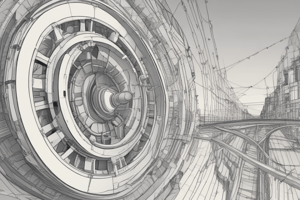Podcast
Questions and Answers
What term is used to describe the location where the curvature of the beam changes direction?
What term is used to describe the location where the curvature of the beam changes direction?
- Shear force
- Point of contraflexure (correct)
- Support reactions
- Maximum bending moment
At the point of contraflexure, what does the bending moment indicate?
At the point of contraflexure, what does the bending moment indicate?
- Constant support reactions
- Minimum shear force
- Maximum absolute value (correct)
- Zero curvature
Why is knowing the maximum bending moment (MBM) essential for beam design?
Why is knowing the maximum bending moment (MBM) essential for beam design?
- To calculate support reactions
- To increase shear force
- To reduce beam curvature
- To determine beam strength under loading conditions (correct)
What do support reactions refer to in structural engineering?
What do support reactions refer to in structural engineering?
Why are shear and moment diagrams crucial for civil engineers?
Why are shear and moment diagrams crucial for civil engineers?
What is the primary purpose of shear and moment diagrams in structural engineering?
What is the primary purpose of shear and moment diagrams in structural engineering?
Which of the following is NOT one of the primary internal forces that affect beams?
Which of the following is NOT one of the primary internal forces that affect beams?
What is the point of contraflexure (POC) in beam analysis?
What is the point of contraflexure (POC) in beam analysis?
What is the purpose of calculating the internal forces in beam analysis?
What is the purpose of calculating the internal forces in beam analysis?
What is the relationship between shear force and bending moment in beam analysis?
What is the relationship between shear force and bending moment in beam analysis?
Flashcards are hidden until you start studying
Study Notes
Shear and Moment Diagrams
Shear and moment diagrams are graphical representations used in structural engineering to analyze the behavior of beams under loading conditions. These diagrams help engineers determine the distribution of internal forces within a structure, which is essential for designing safe and efficient buildings, bridges, and other structures. In this article, we will discuss various aspects of beam analysis, including shear force, bending moment, internal forces, point of contraflexure, and support reactions.
Beam Analysis
Beam analysis is a method used by civil engineers to study how a beam responds when subjected to external loads. This process involves calculating the internal forces such as bending moments and shear forces experienced by the beam. By analyzing these internal forces, engineers can ensure that the beam's design is appropriate for its intended purpose.
Internal Forces
There are two primary types of internal forces that affect beams: shear force and bending moment. Shear force is the horizontal reaction between opposing layers of material, while bending moment is the vertical reaction force acting at right angles to the beam. The distribution of these forces along the length of the beam determines its behavior under load.
Point of Contraflexure
The point of contraflexure (POC) is a crucial feature in the analysis of beams. It refers to the location where the curvature of the beam changes direction, either from concave to convex or vice versa. At the POC, the bending moment reaches its maximum absolute value, indicating a critical point in the beam's behavior. By finding the POC, engineers can determine the maximum bending moment and shear force experienced by the beam.
Maximum Bending Moment
The maximum bending moment (MBM) is the highest magnitude of the bending moment experienced by a beam. It occurs at the point of contraflexure, where the curvature of the beam changes direction. Knowing the MBM is essential for designing beams capable of handling the loads they will encounter during their lifetime.
Support Reactions
Support reactions are the horizontal and vertical forces exerted by a structural member onto the supports upon which it rests. These forces are essential in determining the stability and strength of a structure, particularly in cases involving arches, trusses, or bridges.
In conclusion, understanding shear and moment diagrams is crucial for analyzing the behavior of beams under loading conditions. By examining these diagrams, civil engineers can design structures that are safe and efficient, ensuring that the loads they will experience during their lifetimes can be handled effectively.
Studying That Suits You
Use AI to generate personalized quizzes and flashcards to suit your learning preferences.




